Here's the text.
Great people related to Kanazawa
Last Updated June 12, 2023
The footprints of great men and Kanazawa
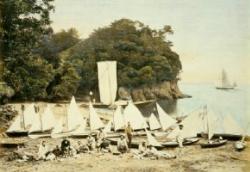
The coast of Tomioka (collected by Yokohama Archives of History)
From the end of the Tokugawa period to the Showa era, many great people prefer the beautiful scenery of Kanazawa and have left footprints in Kanazawa, such as setting up villas.
In particular, there were many villas in the Tomioka area. Sanetomi Sanjo, Kaoru Inoue, Masayoshi Matsukata and other central politics, as well as cultural figures such as Kawai Tamado, built villas in Tomioka one after another.
Sanetomi Sanjo and Kanazawa
Sanetomi Sanjo was a Lord who was active as a politician from the end of the Tokugawa period to the middle of the Meiji era, and was the highest position in the government as Minister of State until the Cabinet system was implemented in 1885.
He was fascinated by the beauty of the coastline of Kanazawa. There is a villa named "Tomioka Kaiso" on the current coast of Tomioka Higashi 2-chome, and around this villa, the coastline from Honmaki to Kannonzaki is drawn mainly.


Tomioka Kaiso Zumaki (Excerpt from the neighborhood of Kanazawa Ward, owned by Yokohama Archives of History)
Hirobumi Ito and Kanazawa (Suzaki Nojima)
Since 1887, the first Prime Minister Hirobumi Ito has been a Kappo Ryokan in Suzaki, Kanazawa and Natsushima Villa (now Natsushima, Yokosuka City). The villa of Hirobumi Ito, which was built on Natsushima from 1887 to 22), drafted the Meiji Constitution.
After that, Hirobumi Ito, who liked the land of Kanazawa, built a villa in Nojima in 1897 (1897). Hirobumi Ito is considering relocating to Kanazawa Bettei at the Akasaka Temporary Imperial Palace (Meiji Constitution Draft Deliberation Hall), and supporting the reconstruction of Shomeiji Temple and Kanazawabunko. It can be said that Nojima was a place with a special meaning as a place related to the drafting of the Constitution.
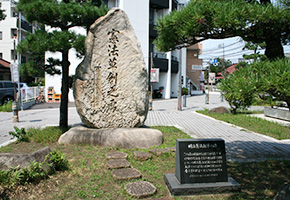
Monument of the Meiji Constitution
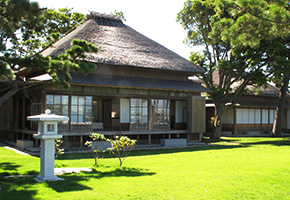
Former Hirobumi Ito Kanazawa Bettei (Yokohama City Tangible Designated Cultural Property)
Hideyo Noguchi and Kanazawa (Nagahama)
Hideyo Noguchi, a research assistant at Shibasaburo Kitasato's Institute of Infectious Diseases, will work in 1899 (1899) as an assistant maritime quarantine officer at a seaport quarantine station in Kanazawa.
We discover plast bacteria from a crew of the North and South America Maru, which happened to call at the port.
He worked for a quarantine station for only five months, but for this achievement, was recommended by his teacher, Shibasaburo Kitasato, and was dispatched as a member of the International Prevention Committee to Kiyokuni Ushiso (New Chan), where the plague was prevalent at the time. . Based on his achievements in Yokohama, he will play an international role.
This bacterium laboratory remains the only research facility in Hideyo Noguchi.
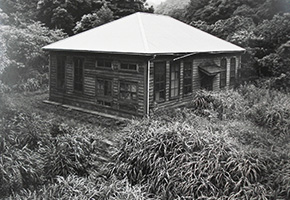
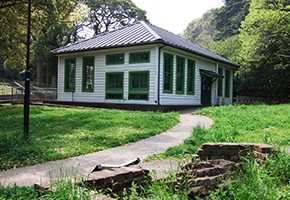
Former bacteria laboratory related to Hideyo Noguchi (photo: provided by Nagahama Hall)
Kawai Gyokudo and Kanazawa (Tomioka)
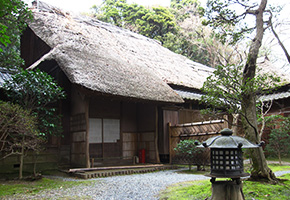
Former Kawai Gyokudo Bettei
Kawai Gyokudo is a master of modern Japanese painters who was active from the Meiji era to the Showa era in Japan, and drew many paintings in Kanazawa.
This mansion was commonly called "Ni Shoan" because there were two old pine trees with good branches in the house.
In the old sketchbook of Gyokudo, there are many sketches around Tomioka, which are beautifully sublimated with works on the theme of spring, such as "Red and White Ume" and "Nagakan", by six songs and one pair.
(The main residence was burned down in October 2013.)
Kiyokata Kaburagi and Kanazawa (Kimigazaki)
Kanazawa and Kimigazaki (now Yatsucho) was chosen as a summer resort by Kiyokata Kaburagi, a Japanese painter who settled in Kamakura, in 1919 (1919).
It has been 20 years since Kiyokata spent a summer day at this villa, Yushin-an.
Kiyokata learned about Kanazawa for the first time in Kanazawa Hakkei of Hiroshige Utagawa, and came to know about this land from the "Edo Famous Zoukai", which is said to be the only figure left by his late father. I will have a longing for Kanazawa.
Kiyokata's memoir "Koshikata no Ki" has a passage entitled "Yushin-an", and Kanazawa at that time is written strongly.
Naoki Thirty-five and Kanazawa (Tomioka)
Sanjugo Naoki, who was active as a popular writer from the end of Taisho to the Showa era, including his representative work Taiheiki Nankoku, set up a new house in Tomioka in 1933.
The famous literary prize, the Naoki Prize, was founded in 1935 by his friendship Hiroshi Kikuchi to commemorate his pioneering achievements.
At present, there is a literary monument in Tomioka ("art is short and poverty is long") and a grave at Choaki-ji Temple. At Choaki-ji Temple, a memorial service and lectures by Naoki Prize-winning writers are held on holidays around February 24, the anniversary of his death every year, under the name of "Nankoku Anniversary" named after his masterpiece "Nankoku Taiheiki". .
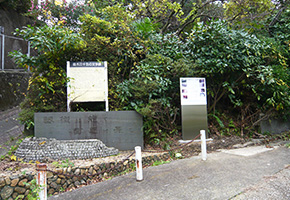
Naoki 35 Literature Monument
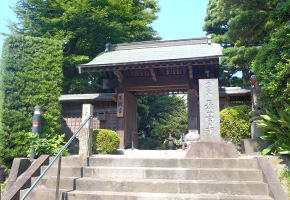
Cho-Akira Temple
Admiral Perry and Kanazawa (Koshiba)
At the end of the Edo period, when Admiral Perry arrived, the seas where the fleet anchored (off the coast of Koshiba Kanazawa Ward, now off Hakkeijima) were named "American Anchorage" by Perry.
Also, when T. Harris arrived later, the Japan-US Osamu Good Commerce Treaty was concluded here.
In order to make the history of Kanazawa Ward widely known to many people and to connect the spirit of Japan-U.S. exchange to the future, a monument was set up in February 2010 at Sea Paradise, Hakkeijima, Yokohama, where visitors can see American Anchorage.
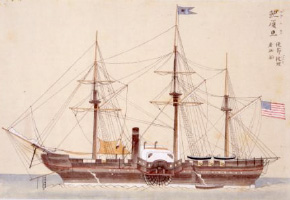
Perry boarded the Pohatan (collected by Yokohama Archives of History)
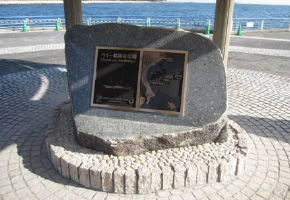
American Anchorage Monument
Inquiries to this page
Kanazawa Ward General Affairs Department Regional Promotion Division
Telephone: 045-788-7804
Telephone: 045-788-7804
Fax: 045-788-1937
Email address: kz-chishin@city.yokohama.jp
Page ID: 545-317-254













